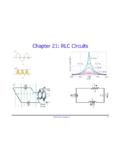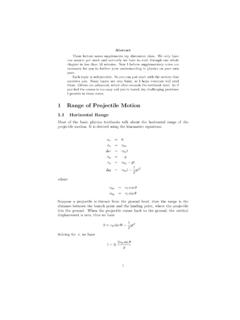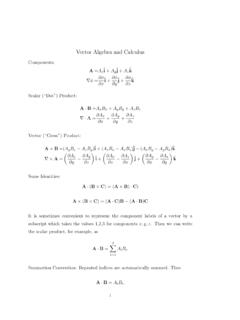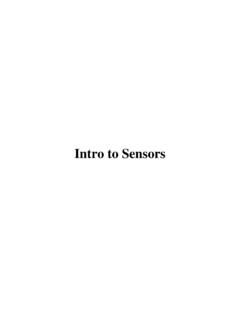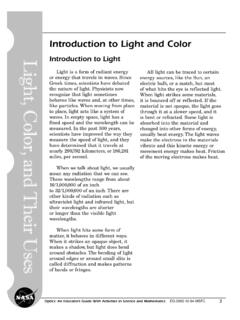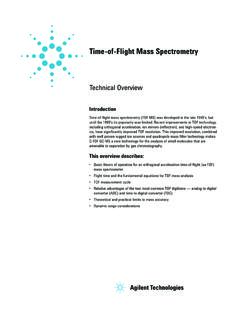Transcription of Exam 2 Solutions - Department of Physics
1 PHY2048 Spring 2017 1 Exam 2 Solutions 1. The figure shows an overhead view of three horizontal forces acting on a cargo canister that was initially stationary but that now moves across a frictionless floor. The force magnitudes are F1 = N, F2 = N, and F3 = N, and the indicated angles are 2 = 30 degrees and 3 = 30 degrees What is the net work done on the canister by the three forces during the first m of displacement? (1) 12 J (2) 92 J (3) 57 J (4) 28 J (5) 0 J The x and y components of F2 and F3 cancel out, leaving only F1 as the net force. So the work done is F1d = 12 J 2. The figure gives the acceleration of a 4 kg object as an applied force moves it from rest along an x-axis from x=0 to x=9 m.
2 The scale of the figure's vertical axis is set by as= m/s^2. What is the object's speed when it reaches x=5 m? (1) m/s (2) 0 m/s (3) m/s (4) 10 m/s (5) 18 m/s Multiplying the acceleration a by the mass is equal to the force applied. So the integral (area) of the force with distance is the work done, which changes the kinetic energy: W= K=madx =4mas=160 Jv=2K/m=8as= J PHY2048 Spring 2017 2 3. The graph shows the potential energy of an object acted upon by a conservative force as a function of its position x. The potential values indicated are: UA = 20 J, UB=25 J, UC=40 J, and UD=50 J. At which of the listed positions in x is the force pointing in the +x (or x) direction with the largest magnitude? (1) m (2) 2 m (3) m (4) 5 m (5) m Fx= dUdx The steepest negative slope gives the largest force in +x (at x=2m), and the steepest positive slope the largest force in the x direction (at x= m) 4.
3 A piece of cheese with a mass of kg is placed on a vertical spring of negligible mass and a spring constant = 1600 N/m that is compressed by a distance of 10 cm. When the spring is released, how high does the cheese rise from the release position? (The cheese and the spring are not attached.) (1) m (2) 33 m (3) m (4) 16 m (5) m Use conservation of mechanical energy before the spring launch and at the maximum height: Emec=K+Us+Uginitially:Emec=12kx2finally: Emec=mghh=kx22mg= m PHY2048 Spring 2017 3 5. In the figure here, a small block is sent through point A with a speed of m/s. Its path is without friction until it reaches the section of length L, where the coefficient of kinetic friction is The indicated heights are h1 = m and h2 = m.
4 What is the minimum length of L such that the block comes to rest? (1) m (2) m (3) m (4) m (5) m First find the speed at point C using conservation of mechanical energy KA+UA=KC+UC12mvA2+mgh1=mgh2+12mvC2v=vA2+ 2gh1 h2() The deceleration is caused by friction. We can solve for the length: 0=v2+2aL v2= 2 Kg()LL=vA2+2gh1 h2()2 Kg=vA22 Kg+h1 h2() K= m 6. A kg ball moving horizontally at m/s strikes a vertical wall and rebounds in the opposite direction at m/s. If the collision took place in s, what was the magnitude of the average force on the wall? (1) 100 N (2) 200 N (3) 0 N (4) 50 N (5) 10 N J= p=Fav tmv2 v1() t= ()10 10()m/s() s=100 N PHY2048 Spring 2017 4 7. In the figure shown, a 10 g bullet moving directly upward at 1000 m/s strikes and becomes lodged within the center of a 10 kg block initially at rest.
5 To what maximum height does the block and embedded bullet then rise above its initial position? (1) m (2) m (3) m (4) 1 m (5) 50 m Use momentum conservation to solve for the initial vertical velocity of the block and bullet, which is an inelastic collision: mbvb=Mblk+mb()VV=mbvbMblk+mb()=1 m/s Then use conservation of mechanical energy to find the maximum height 12 MblkV2=Mblkghh=V22g= m 8. At the intersection of 13th Street and University Avenue, a subcompact car with mass 900 kg traveling east on University collides with a pickup truck with mass 2700 kg that is traveling north on 13th St. and ran a red light . The two vehicles stick together as a result of the collision and, after the collision, the wreckage is sliding at m/s in the direction 24 east of north as shown in the figure.
6 The collision occurs during a heavy rainstorm; you can ignore friction forces between the vehicles and the wet road. Calculate the speed of the car (or truck) before the collision. PHY2048 Spring 2017 5 (1) 20 m/s (2) 26 m/s (3) 58 m/s (4) 9 m/s (5) 16 m/s mcarvcar=mcar+mtruck()vfsin vcar=mcar+mtruck()mcarvfsin24!=26 m/s mtruckvtruck=mcar+mtruck()vfcos vtruck=mcar+mtruck()mtruckvfcos =20 m/s 9. A bomb at rest explodes into two fragments, one of mass m1 and one of mass m2, that travel in opposite directions. What is the ratio of the kinetic energy of the fragment of mass m1 to the kinetic energy of the fragment of mass m2 (or the inverse for some exams)? (1) m2/m1 (2) m1/m2 (3) m22/m12 (4) m12/m22 (5) 1 Use conservation of momentum, then calculate the ratio of kinetic energies.
7 M1v1+m2v2=0v2= m1m2v1K1K2=12m1v1212m2v22=m1m2v12m12m22v 12=m2m1 PHY2048 Spring 2017 6 10. An electric fan is turned off, and its angular velocity decreases uniformly from 500 revolutions per minute to 200 revolutions per minute in a time interval of length 3 s. How many more seconds are required for the fan to come to rest? (1) 2 (2) 3 (3) 5 (4) 1 (5) 4 Find the angular acceleration: 2= 1+ t = 2 1()t=200 500 rev/min()1 min/ 60 s()3s= rev/s2 Then the total time to rest: t3= 3 1() =0 500 rev/min()1 min/ 60 s() rev/s2=5 s so the additional time was 2 s 11. A disk rotates about its central axis starting from rest and accelerates with constant angular acceleration. At one time it is rotating at 10 rev/s; 50 revolutions later, its angular speed is 25 rev/s.
8 Calculate the angular acceleration in rev/s^2. (1) (2) (3) (4) (5) 22 12=2 = 22 122 =25 rev/s()2 10 rev/s()2250 rev()= rev/s2 12. A light string is wrapped around the edge of a metal disk and a kg block is suspended from the free end. The radius of the disk is m and its rotational inertia is kg m^2. If the block is released from rest m above the floor, what is the speed just before it strikes the floor? PHY2048 Spring 2017 7 (1) m/s (2) 50 m/s (3) m/s (4) 22 m/s (5) m/s Energy arguments can be used: Kdisks+KB+UB= 2+12mBvB2 where vB=R1 mBgh=12mBvB21+IdisksmBR12 vB=2gh1+IdisksmBR12 = m/s 13. A solid cylinder of mass 10 kg rolls up an incline at an angle of 30.
9 At the bottom of the incline the center of mass of the cylinder has a translational speed of m/s. How far does the cylinder travel up along the path of the incline? (1) m (2) m (3) m (4) m (5) m Energy arguments can be used: K+U= +12I 2=mgh12mv21+Imr2 =mg sin =12gsin v21+12mr2mr2 = ()= m PHY2048 Spring 2017 8 14. The figure illustrates an Atwood's machine, where two masses m1 and m2 are suspended by a cord over a pulley. The larger mass is m2. In terms of the acceleration a of the masses, which is in the direction of the arrows shown, what is the tension of the cord connected to mass m2 (or m1)? (1) m2(g-a) (2) m1(g+a) (3) m2(g+a) (4) m1(g-a) (5) m2 a Forces acting on m2: m2g T2=m2aT2=m2g a() Forces acting on m1: T1 m1g=m1aT1=m1g+a() 15.
10 A small block on a frictionless, horizontal surface has a mass of kg. It is attached to a massless cord passing through a hole in the surface. The block is originally revolving at a distance of m from the hole with an angular speed of 1. The cord is then pulled from below, shortening the radius of the circle in which the block revolves to m. Model the block as a particle. What is the new angular speed of the block? (1) 4 1 (2) 2 1 (3) 1 (4) 1/2 (5) 1 / 4 PHY2048 Spring 2017 9 Conservation of angular momentum I1 1=I2 2mr12 1=mr12/4() 2 2=4 1 16. A diving board of length m is supported at a point m from the end, and a diver weighing 600 N stands at the free end. The diving board is taken to be massless.
